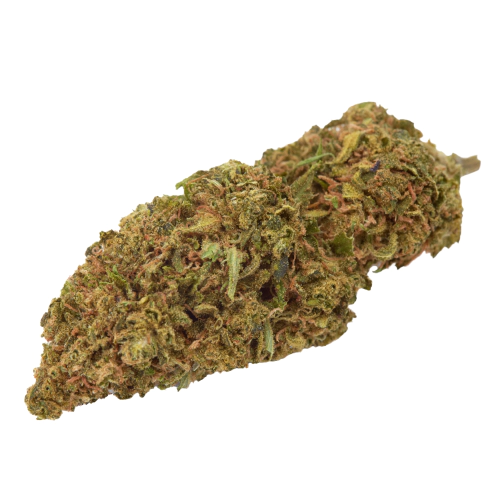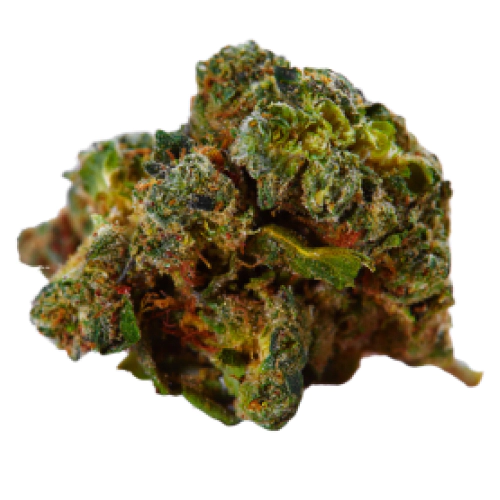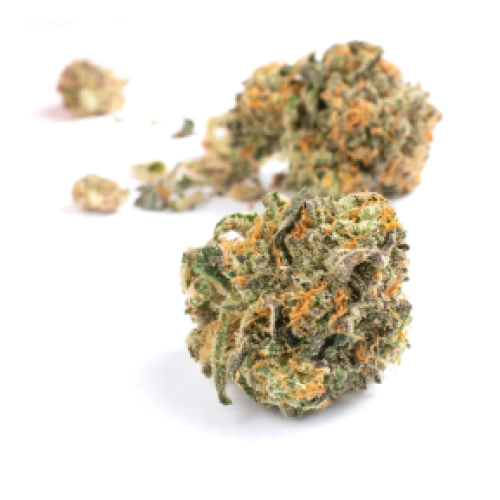THC 18.5 - 22.25%
CBD 0.55 - 0.96%
Effect Relaxed
Flavor Skunk
18.99 - 19.01%
0.08 - 0.2%
0.2 - 0.39%
Lemon, Orange
Concentrated
We cannot say exactly about the origin of this weed, but what we do know is that it’s a typical hybrid of Sativa and Indica compounds. It contains extremely low volumes of CBD components, which is around 0.08 - 0.2%, and medium amounts of THC - up to 19%. 0.25% of its content are taken by the caryophyllene terpene, whereas the rest of the terpenes profile looks as follows:
Physical features are what you see and what you taste or smell. The Ginger Snap strain has a pale-green color combined with some orange hues. Both colors and tastes of the cannabis strain are determined by the terpene content. In this case, the combination of caryophyllene and myrcene terpenes provides flavors of rose. Together with the limonene terpene, caryophyllene evolves lemon smells and might also provide pine aromas.
This strain won’t harm you if you smoke proper doses of a quality product. However, it still provides some side effects, which are especially common for inexperienced consumers:
Despite this, it has plenty of positive effects. Ginger Snap weed strain makes you focused and concentrated. You can also take it if you want to entertain people because this weed can really boost your creativity. In addition to this, it relieves people from chronic migraines and muscle spasms. If you suffer aches caused by some kind of inflammation, Ginger Snap won’t harm you, too.
Ginger Snap is worth cultivating because you can harvest the 1 - 2 Oz/Ft² (~ 400 g/m²) yield in just 60 days after planting in indoor conditions. The temperature should not exceed 30 °C, and the appropriate watering regime is necessary.
| THC | Tetrahydrocannabinol, or THC, is a major cannabis chemical compound. It is a psychoactive element that stimulates dopamine release and induces euphoria or happiness. THC-rich strains may be helpful with such conditions as lack of appetite, chronic pains , etc. It is considered to be the primary active marijuana component. | 18.99 - 19.01% |
| CBD | Cannabidiol, or CBD, is a major compound in cannabis, which is non-psychoactive. It is also proved to counteract the side effects of the second major component THC. CBD is widely used for medicinal purposes in rubs, oils and so on. It is helpful in muscle pain cases, may treat arthritis and migraines. Even Greeks used it against pain, while Queen Victoria applied it to get rid of menstrual cramps. | 0.08 - 0.2% |
| CBC | Cannabichromene, or CBC, is a minor cannabinoid, meaning that its quantity in cannabis is quite little. Though it has the same origin as CBD and THC, it is different in functions. Without any psychoactive effects, it is an efficient cannabis compound in combating acne and depression. CBC produces analgesic, antibacterial and anti-inflammatory effects. | 0.21 - 0.34% |
| CBG | Cannabigerol, or CBG, is one of the minor cannabis compounds in adult plants. On the other hand, young ones contain a lot of this antibacterial and anti-inflammatory component. During the growth, CBG is converted into different cannabinoids, mostly THC and CBD. The compound itself increases appetite and decreases eye pressure. | 0.2 - 0.39% |
| CBN | Cannabinol, or CBN, is a trace element in cannabis that is considered to be mildly psychoactive. It appears from oxidation THC, exposed to light and heat. CBN is mostly contained in old cannabis and in traditional hashish. It is effective against insomnia, bacterial infections and appetite loss. | 0.36 - 0.49% |
| THCV | Tetrahydrocannabivarin, or THC-V, is a compound contained in cannabis in trace amounts. Even though it is close to THC molecularly, it is different in effects. This compound may be psychoactive only in large amounts. THC-V reduces blood sugar, controls appetite, stimulates bone growth, etc. African Sativa strains are the richest in THC-V. | 0.02 - 0.09% |
| Pinene | Pinene is one of the most widespread terpenes in nature, found in pine trees, basil, nutmeg, parsley, and rosemary. Cannabis containing terpene (alpha-pinene or α-pinene) boasts a strong pine scent. Pinene is responsible for anti-inflammatory, pain-relieving, and anti-anxiety effects. | 0.07% |
| Myrcene | Myrcene (also known as β-myrcene) is one of the most common terpenes found in cannabis, representing more than 20% of the modern marijuana terpene profile. Myrcene has a distinct earthy, musky flavor, resembling cloves. It is responsible for calming and soothing effects of weed. Myrcene is also found in hops, thyme, mango, lemongrass, guava melon. | 0.23% |
| Ocimene | Ocimene (derived from the Ancient Greek word Ocimum meaning basil) is a terpene with sweet and herbaceous flavors, also boasting citrusy and woody undertones. Naturally, ocimene occurs in mint, parsley, orchids, hops, kumquats, mangoes, basil, bergamot, lavender, and pepper. Offers antifungal, anti-inflammatory, and antiviral properties. | 0.01% |
| Humulene | Humulene (also known as α-humulene) is one of the major terpenes found in cannabis, contributing to woody, earthy, spicy, herbaceous, and, mainly, floral aromas of cannabis. Used in modern medicine, humulene offers anti-inflammatory, antibacterial, and appetite suppressant effects, which have been well-researched by pharmaceutical companies. | 0.11% |
| Limonene | Limonene (also known as d-limonene) is the second most common terpene in nature and the third most common terpene in cannabis. It has a powerful citrus aroma and can be found in all citruses, including lemons, oranges, grapefruits, limes, juniper, etc. Limonene is known to elevate moods and provide anxiety, depression, and stress relief. | 0.26% |
| Linalool | Linalool (also known as beta linalool, linalyl alcohol, linaloyl oxide, and p-linalool) is one of the rarest terpenes found in cannabis, mostly in small quantities. Linalool is known for its spicy and lavender aroma, bringing relaxation and calming effects. It is also said to provide anti-inflammatory and analgesic properties that can be useful for athletes. | 0.04% |
| Terpinolene | Terpinolene is one of the most common terpenes found in cannabis; however, It's usually presented in small quantities. Is responsible for piney, floral, herbaceous, and even a little bit citrusy aroma of cannabis. Terpinolene can be found in lilacs, nutmeg, and cumin. In cannabis, terpinolene contributes to the sensation of "freshness." Has the potential to reduce the risk of heart diseases. | 0.02% |
| Caryophyllene | Caryophyllene (also known as beta or b caryophyllene) is a terpene found in many herbs and spices, such as black pepper, basil, rosemary, and oregano. Cannabis high in caryophyllene delivers a strong spicy, peppery aroma, resembling cinnamon and cloves. Caryophyllene offers potent anti-inflammatory and sedative effects. | 0.25% |
| Total terpenes content | 0.99% |
THC 18.5 - 22.25%
CBD 0.55 - 0.96%
Effect Relaxed
Flavor Skunk
THC 19 - 24%
CBD 0.18 - 0.72%
Effect Concentrated
Flavor Tar
THC 13.5 - 17%
CBD 0.07 - 0.26%
Effect Concentrated
Flavor Butter
THC 11 - 13%
CBD 0.04 - 0.38%
Effect Giggly
Flavor Pear
THC 18.75 - 24.75%
CBD 0.06 - 1.9%
Effect Hungry
Flavor Chestnut
THC 15 - 17%
CBD 0.36 - 0.64%
Effect Relaxed
Flavor Sage
THC 21 - 27.25%
CBD 0.02 - 0.44%
Effect Uplifted
Flavor Vanilla

THC 6 - 13%
CBD 1 - 2%
Effect Hungry
Flavor Strawberry
THC 20.5 - 29%
CBD 0.37 - 1.27%
Effect Giggly
Flavor Sweet
THC 14 - 20%
CBD 0.74 - 0.96%
Effect Tingly
Flavor Pine
THC 15 - 17%
CBD 0.07 - 0.31%
Effect Euphoric
Flavor Spicyherbal

THC 19 - 22.5%
CBD 1.04 - 1.18%
Effect Uplifted
Flavor Lemon

THC 17 - 20%
CBD 0.57 - 1.02%
Effect Tingly
Flavor Sweet
THC 21.2 - 25.2%
CBD 0.37 - 8.08%
Effect Creative
Flavor Spicyherbal
THC 18 - 22%
CBD 0.88 - 1.06%
Effect Giggly
Flavor Strawberry
Be the first and share your opinion
Write a Review